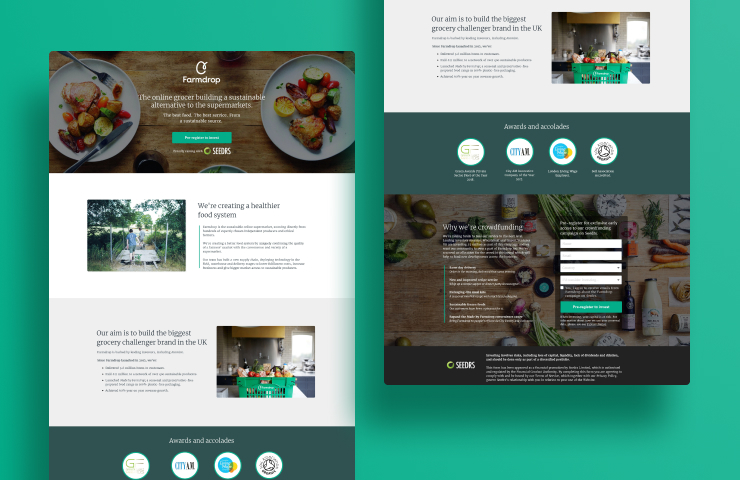
Written by Theo Bishop, a Senior Investment Associate at Seedrs, helping businesses launch and run successful crowdfunding campaigns.
In this guide, we’ll look at the different elements of promoting your campaign that contribute to campaign success, divided by the three key phases: pre-launch, private and public.
Pre-Launch
Marketing your campaign starts before you even go live. You need to activate your network and maximise awareness of your business among your ideal investor base consistently from pre-launch all the way to the close of your campaign. Most businesses on Seedrs typically dedicate at least three weeks to planning and spreading the word before launching privately to their community.
Identify Your Audiences
Start with identifying where the potential investment will come from to help you prepare your outreach strategy. You’ll want to consider the following:
1. Who are your direct investors? Consider family, friends or angel investors you’ve been in contact with who will contribute to lining up 30% of your target before launching to the crowd.
2. How will you reach out to your community? Consider existing users, customers and social media followers who will contribute to lining up an additional 30% of your target prior to launching to the crowd.
3. How will you engage the crowd once your campaign goes live?
Get a Plan in Place
There’s a direct correlation between the speed and amount a business raises and the level of time and effort spent preparing the campaign. It’s crucial to plan your marketing in the beginning so that you can hit the ground running when the campaign goes live. It will run for up to 40 days – this will go by in a flash, so it’s important to be adequately prepared.

A crowd doesn’t tend to start a round, they tend to join a round. Be really confident before you go live that you have some commitments, so you’ve got that momentum to start it. You want to keep that momentum going and show progress across your raise – not have everything go all-in on day one.
Tom Ball, Founder at Desk Lodge
Pre-Registration
You’ll want to start gauging investor interest from your networks and customers. A tried-and-tested method that we typically recommend is to create a pre-registration landing page. This will help you secure a lead list that can be leveraged for marketing purposes to drive potential investors to your campaign.

There is no obligation to do this, but it does help you gauge how much investment you may get from your existing network and how many people are interested in being a part of it. And it gets people excited!

Get the Word Out
You’ll want to maintain a level of exclusivity to your existing network and customers, so focus your pre-launch outreach via:
- A homepage banner, popup or app notification directing users and visitors to the pre-registration page
- An email to your mailing list subscribers about your upcoming campaign and link through to the pre-registration page
Ideally, you’ll want to do this no earlier than two weeks before your campaign – any earlier and people might forget, and you may lose all the momentum you’ve built!
Private Campaign
Now is the time to start converting all that excitement into action. Only people with the URL to your campaign will have access at this stage, so it will not be public to a wider audience. This will let you manage the launch in a controlled way.
Building Momentum
When you launch your private campaign, plan to invite everyone who pre-registered their interest, and from the lists you prepared. This will, ideally, generate early momentum into the campaign and create a great foundation for new investors to become interested when your campaign is open publicly.
There’s no hard and fast science to this, but as a general rule of thumb, we suggest having as many individuals as possible invested in the campaign. 50-100 investors tend to be a good goal that many campaigns strive for. And we’d suggest keeping the timing tight, aiming to generate this activity during a private campaign of three to five days before opening it up to the public.
Public Campaign
When your campaign is public, anyone can view it on the Seedrs platform. This is where all your hard work pays off and (hopefully) momentum really starts to snowball as new investors and repeat Seedrs investors take notice. You’ve already reached out to your direct audiences, so this is when you want to use tactics that will drive a more public audience to learn about the business opportunity to ensure that everyone who may be interested in taking part knows about the opportunity.
Communications and Social Media
Be relentless with your communications during your campaign, both on your crowdfunding campaign and outside of the campaign. From social media posts to emails, shout about your successes and keep encouraging them to find out more about your campaign. Deck out your social profiles, images and headers to let people know you’re crowdfunding. And make sure you’re talking about your raise and any milestones you hit throughout your campaign to make people aware that the business is keeping busy.
Don’t just keep social posts to your brand accounts either! Get team members to talk about your raise to widen the net even further.
Use a lot of imagery in your posts, tailor your messages to suit each platform and schedule posts throughout the day to ensure maximum exposure and multiple touchpoints.
Related content: 3 Tips to Get your Campaign’s Social Media Timing and Content Right.
Related content: Create a Social Media Content and Communications Plan for Your Campaign in 10 Steps.
Website and Product
You may find more organic search traffic to your website or app because during your raise. Design a homepage banner or pop up message to redirect visitors to your campaign page to make the most of the increased exposure.
Events
This is also the point in the campaign when any events you planned during the preparation phase should happen. Meet as many potential investors as possible, but don’t limit this to just your own events. Attend events you think might be useful for networking within your industry or the investment sphere.
A Final Note: A Compliant Campaign is a Successful One!
You should be aware that your marketing of the campaign may involve financial promotions. We have prepared some frequently asked questions that you should be aware of to help you run an engaging and compliant campaign here.



